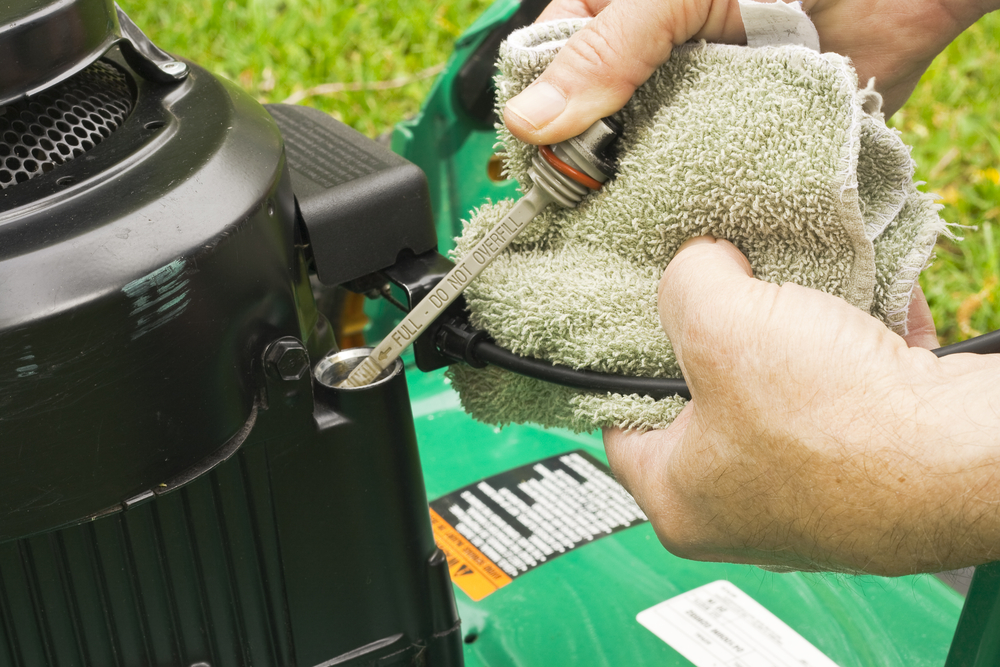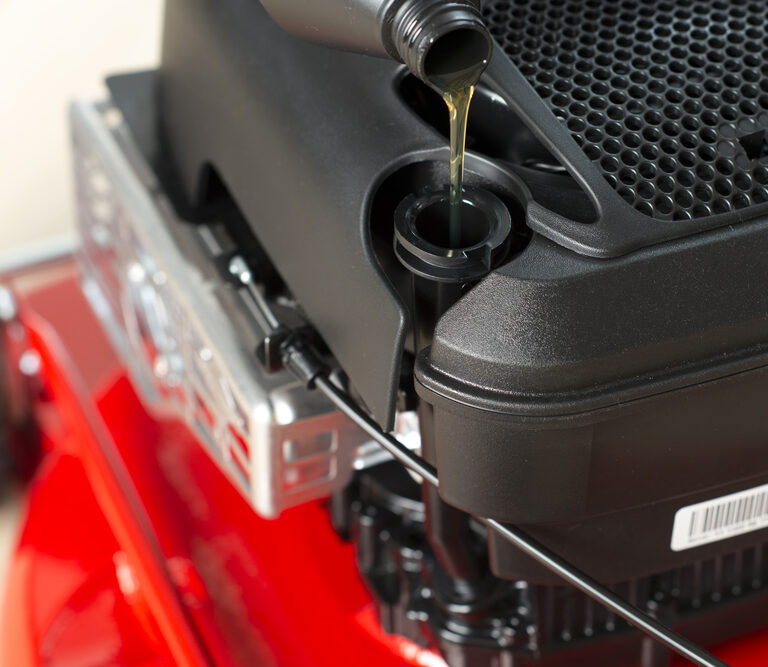Gas lawn mowers are relatively simple tools, as you fill them with fuel, squeeze the primer bulb, and pull the cord to get them to start. However, they require periodic maintenance to keep them functional, so you’ll want to learn a bit about lawn mower oil after buying one.
When seeking information on lawn mower oil, you should know that there’s a little more to it than purchasing the first bottle you see. You’ll need to ensure you buy the right type and put the optimal amount into the mower to keep it running for years to come.
You’ll also need to change the oil periodically because old oil breaks down and doesn’t provide sufficient lubrication. Here’s everything you need to know about oil for your lawn mower.
Why Lawn Mower Oil Is Important
Only gas-powered lawn mowers use oil, as electric and battery-powered products don’t need the same lubrication in their engines. If you have a gas lawn mower, though, oil is an essential component.
Internal combustion engines contain moving parts that work at high temperatures and speeds. Minimizing friction is essential because as these parts move, they can cause the engine to seize, overheat, or wear down.
Much like you’d never run your car without motor oil, you never want to attempt to start your mower without adequate lubrication.
What Type of Oil to Use
A few factors help determine the type of motor oil you’ll use in your lawn mower. It’s vital that you carefully look at your mower and its manual to ensure you end up with the ideal oil type to meet your needs.
Type of Engine
First, you’ll need to determine if you have a two-cycle or four-cycle engine. Fortunately, it’s easy to figure this out because two-cycle engines call for you to mix the gas and oil together in a single fill port, while four-cycle engines have separate fill ports for each. Your lawn mower’s manual will also have this information.
If you have a two-cycle lawn mower, you can’t use traditional motor oil. Instead, you’ll have to invest in a lightweight small engine oil with an APR performance rating of SF, SH, SG, or S.
Most lawn mowers have four-cycle engines, which is good news because you can go with traditional motor oil like you’d use in your car. However, it’s essential to consider your climate and the temperatures in which the mower will be operating to ensure you purchase the best one.
Outdoor Temperature
Your area’s climate is vital because extreme heat and cold are hard on motors and will influence the motor oil that you purchase.
SAE 30 is the most common oil used in these units because it works well in temperatures between 40 and 100 degrees Fahrenheit. Keep in mind that you’ll have a tough time starting your lawn mower if you need to run it when it’s below 40 degrees Fahrenheit, but you’d rarely mow your lawn in those conditions anyway.
If you must operate your mower in cold temperatures, SAE 5W-30 is the way to go. However, this product doesn’t work as well when it gets extremely hot outside. You might also consider SAE 10W-30 for cold weather while remembering that it has difficulties when the temperature exceeds about 80 degrees Fahrenheit.
When choosing motor oil for your lawn mower always go with high-quality detergent products classified as SF, SG, SH, SJ, or higher. You’ll also want to avoid oils with additives.
Synthetic Oil
It’s possible to use synthetic oil in four-cycle engines, which comes with the added benefit of being adaptable to many different climates.
Synthetic SAE 5W-30 and 10W-30 are top choices because they work well in warm and cold temperatures, offering the best possible protection in nearly any weather. The 10W-30 option works particularly well in cold climates. You’ll also find that you consume less oil when using these products.
There’s also 15W-50 synthetic oil, which you probably won’t use in your at-home lawn mower unless you have a high-end, commercial-grade unit for your residential property.
Overall, synthetic oil is recommended because it provides better protection, albeit at a higher price point.
Checking Lawn Mower Oil Levels

Much like you’d find under the hood of a car, lawn mowers have a dipstick that you can use to check the oil levels.
The process is simple, as the dipstick is located under your oil cap. It’ll likely say “Oil” on the lid or have a correlating picture, so all you have to do is turn it counterclockwise and remove it.
You’ll then see that the dipstick has holes or lines on it. These markings indicate how much oil you have in the tank. Ideally, the oil level will sit between the two marks, but if it’s above the high mark or below the low mark, it means you have too much or too little oil in the engine.
It’s also worth noting that you should change your mower’s oil at least once per season or every 50 hours of use. If you have a riding mower, you can get away with changing it every 100 hours, but changing it once per year remains essential.
Keeping oil levels at optimal levels and doing a complete change once per year help maintain your mower’s performance for years to come.
How Much Oil You Need
As you’re looking at the motor oil options in a local hardware store, you might be wondering how much you need. Once again, it depends on your unit, but there are some general parameters to follow.
For a walk-behind push mower, the oil capacity is probably either 15 or 18 ounces. A typical bottle of oil contains 32 ounces of product, so you might get two oil changes out of each purchase. Remember, you can store an opened bottle of motor oil for up to five years, so hold onto any extra you buy for the following year.
A ride-on mower is a larger product, so it makes sense that it requires more motor oil. These items generally need either 48 or 64 ounces of oil, depending on the engine, so you’ll need two bottles per year.
For a two-cycle engine, the amount of oil you’ll require varies, but you’ll have to mix the oil and gas together. The ratio is usually 40:1 or 50:1, so for every 40 or 50 parts gas, you’ll need one part of oil. It’s best to mix the oil and gas in a can before you begin.
Ensure you never over-fill the engine with oil, and check your owner’s manual before changing the oil in your lawn mower to achieve the best results.
Changing Your Lawn Mower Oil
Now that you have your lawn mower oil and know that it’s time to change it out, it’s time to start the process. Fortunately, changing the oil in a lawn mower is far easier than with a car because you don’t need to get under the mower to make it happen.
Start by getting a container for the oil and grabbing a funnel to prevent it from spilling in your yard or driveway. You’ll then want to find the dipstick and remove it.
When changing the oil in a lawn mower, you’ll have to tip the unit over and pour the oil into the container. Make sure you pour away from the air filter and spark plugs to prevent damage to the mower as you drain. The filter and plugs are on the opposite side of the oil reservoir, so tip the mower toward the dipstick tube until it empties.
From there, you can add a new batch of whatever oil you’ve selected. Check the dipstick a couple of times as you fill the reservoir, so you don’t end up with too much or too little oil.
When changing the oil in a ride-on mower, start by disconnecting the spark plugs, removing the lower-right dash cover, and pulling off the oil drain valve cap that sits behind the cover.
You’ll then attach an oil drain tube to the unit, turn the valve counterclockwise to unlock it, and remove the dipstick to get the oil flowing. Make sure you have an oil pan or something else underneath the tube to catch the oil before this step.
Once all of the oil is drained, you can add new oil into the dipstick tube while carefully checking the levels periodically, so you don’t end up over-filling it.
Final Thoughts
Dealing with your lawn mower’s oil is a relatively straightforward process that should become part of your regular yard tool maintenance. Putting fresh oil in your mower and ensuring it’s always at optimal levels will keep the unit running well for years to come, guaranteeing you don’t have to fork out any money to replace it anytime soon. It will also save you some stress because you won’t have to worry about your mower not starting as you attempt to fire it up in the spring.
